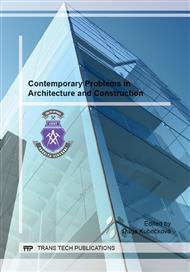[1]
R. A. Muller, I. A. Petukhov, Analysis of buildings in undermined areas from expected values of the soil base sag (bulge), Soil Mechanics and Foundation Engineering, 1987, Volume 24, Issue 4, pp.142-144, Russia.
DOI: 10.1007/bf01716864
Google Scholar
[2]
P. Mynarcik, Technology and Trends of Concrete Industrial Floors, Procedia Engineering, Volume 65, 2013, Pages 107-112, ISSN 1877-7058, doi: 10. 1016/j. proeng. 2013. 09. 019.
DOI: 10.1016/j.proeng.2013.09.019
Google Scholar
[3]
M. Stara, M. Janulikova, Laboratory measurements and numerical modeling of pre-stressed masonry, Procedia Engineering, Volume 65 (2013), Pages 411-416, ISSN 1877-7058, doi: 10. 1016/j. proeng. 2013. 09. 064.
DOI: 10.1016/j.proeng.2013.09.064
Google Scholar
[4]
M. Janulikova, R. Cajka, P. Mateckova, V. Buchta, Laboratory Testing of Asphalt Belts Rheological Properties Exposed to Shear Loads, Transactions of the VSB - Technical University of Ostrava, Civil Engineering Series, Volume XII, Issue 2, Pages 59–66, ISSN (Online) 1804-4824, ISSN (Print) 1213-1962, doi: 10. 2478/v10160-012-0018-2, January (2013).
DOI: 10.2478/v10160-012-0018-2
Google Scholar
[5]
M. Janulikova, Behavior of selected materials to create sliding joint in the foundation structure, Advanced Materials Research, Volumes 838 – 841 (2014).
DOI: 10.4028/www.scientific.net/amr.838-841.454
Google Scholar
[6]
M. Janulikova, M. Stara, Multi-layer Rheological Sliding Joint in the Foundation Structures, Transactions of the VŠB – Technical University of Ostrava, Civil Engineering Series, Volume XIII, Issue 2, Pages 41–46, ISSN (Online) 1804-4824, ISSN (Print) 1213-1962, doi: 10. 2478/tvsb-2013-0008, December (2013).
DOI: 10.2478/tvsb-2013-0008
Google Scholar
[7]
M. Janulikova, Comparison of the shear resistance in the sliding joint between asphalt belts and modern PVC foils, Applied Mechanics and Materials, Volumes 501 – 504 (2014).
DOI: 10.4028/www.scientific.net/amm.501-504.945
Google Scholar
[8]
M. Janulikova, M. Stara, Reducing the shear stress in the footing bottom of concrete and masonry structures, Procedia Engineering, Volume 65 (2013), Pages 284 – 289, ISSN 1877-7058, doi: 10. 1016/j. proeng. 2013. 09. 044.
DOI: 10.1016/j.proeng.2013.09.044
Google Scholar
[9]
R. Cajka, R. Fojtik, Development of Temperature and Stress during Foundation Slab Concreting of National Supercomputer Centre IT4, Procedia Engineering, Volume 65, 2013, Pages 230-235, ISSN 1877-7058, DOI: 10. 1016/j. proeng. 2013. 09. 035.
DOI: 10.1016/j.proeng.2013.09.035
Google Scholar
[10]
R. Cajka, P. Mateckova, Temperature Distribution of Slide Joint in Reinforced Concrete Foundation Structures, 17th International Conference on Engineering Mechanics 2011, Svratka, May 09-12, 2011, Engineering Mechanics 2011, pp.95-98.
Google Scholar
[11]
M. Krejsa, R. Cajka, The foundation slab monitoring of the National Supercomputing Center - IT4 Innovations, during construction. 11th International Probabilistic Workshop 2013 (IPW11), Brno, Czech Republic, November 6-8, 2013, ISBN 978-80-214-4800-1.
Google Scholar
[12]
R. Cajka, Comparison of the calculated and experimentally measured values of settlement and stress state of concrete slab on subsoil, Applied Mechanics and Materials, Volumes 501 – 504 (2014).
DOI: 10.4028/www.scientific.net/amm.501-504.867
Google Scholar
[13]
R. Cajka, K. Burkovic, V. Buchta, Foundation Slab in Interaction with Subsoil, Advanced Materials Research, Volumes 838-841, (2014), pp.375-380, Trans Tech Publications, Switzerland, doi: 10. 4028/www. scientific. net/AMR. 838-841. 375.
DOI: 10.4028/www.scientific.net/amr.838-841.375
Google Scholar
[14]
R. Cajka, K. Burkovic, V. Buchta, R. Fojtik, Experimental soil - Concrete plate interaction test and numerical models, Key Engineering Materials, Volumes 577-578 (2014).
DOI: 10.4028/www.scientific.net/kem.577-578.33
Google Scholar
[15]
V. Buchta, P. Mynarcik, Experimental testing of fiberconcrete foundation slab model, Applied Mechanics and Materials, Volumes 501 – 504 (2014).
DOI: 10.4028/www.scientific.net/amm.501-504.291
Google Scholar
[16]
R. Cajka, J. Labudkova, Influence of parameters of a 3D numerical model on deformation arising in interaction of a foundation structure and subsoil, 1st International Conference on High-Performance Concrete Structures and Materials (COSTMA '13), Budapest, 2013, ISSN 2227-4359, ISBN 978-960-474-352-0.
Google Scholar
[17]
R. Cajka, Accuracy of Stress Analysis Using Numerical Integration of Elastic Half-Space (2013).
Google Scholar
[18]
R. Cajka, Analysis of Stress in Half-space using Jacobian of Transformation and Gauss Numerical Integration, Advanced Materials Research, Vol. 818 (2013).
DOI: 10.4028/www.scientific.net/amr.818.178
Google Scholar


